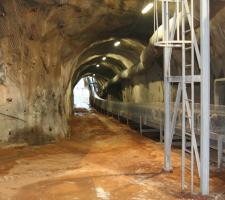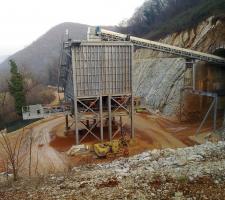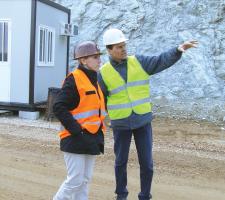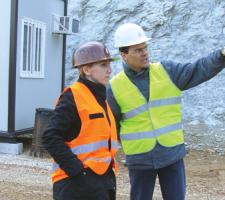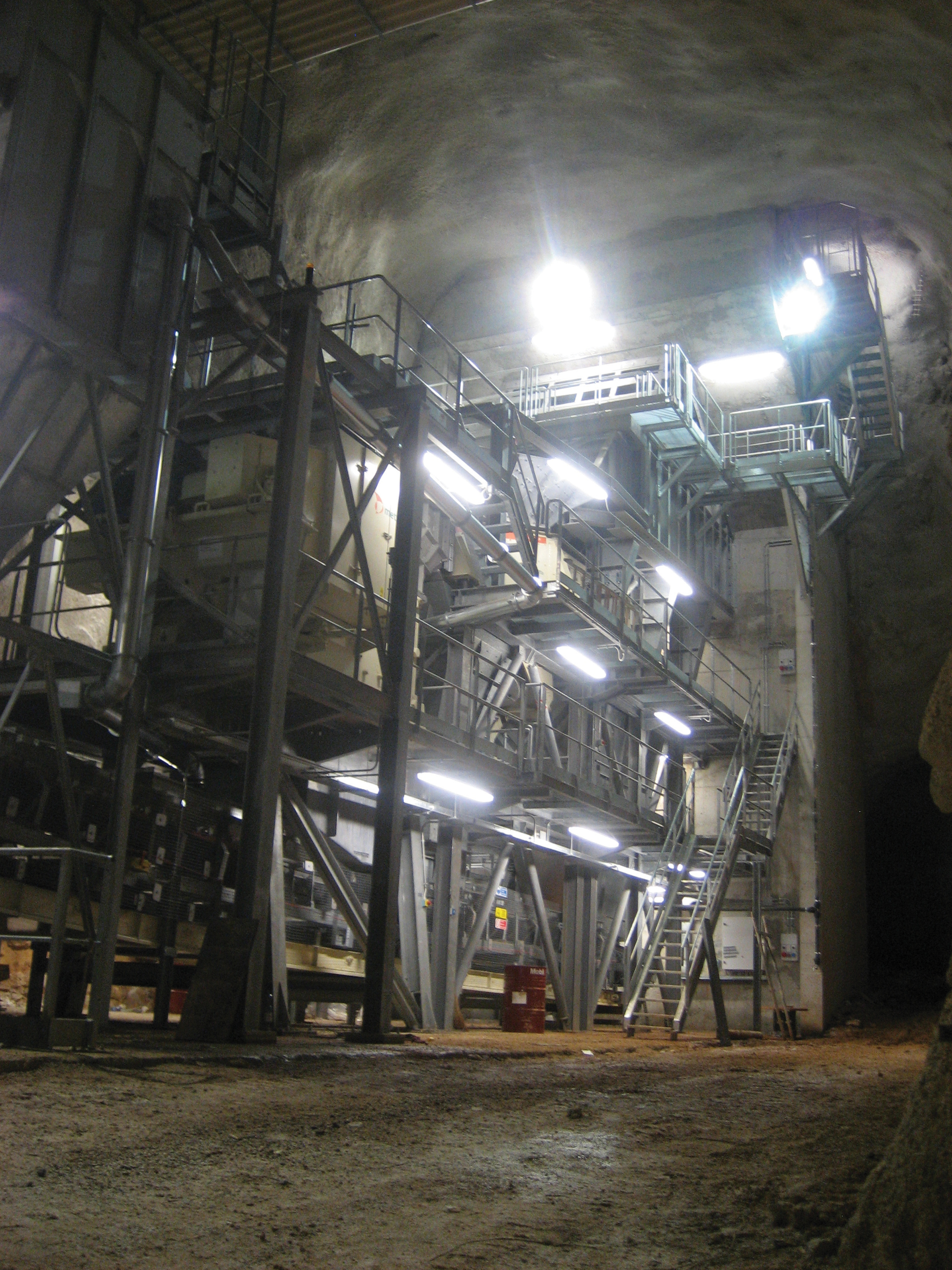
Securing Resources to meet future demand is a key part of Fassa Bortolo's investment in a new quarry in the Brescia region of Italy but it is environmental issues that have guided the design. Claire Symes reports
As you enter the main gates of most quarries, it is clear from the hive of hauling, crushing and screening activity that you are in an active aggregates operation. But this is not the case in one of Italy's newest quarries where the production is carried out deep underground, some 85m below the quarry floor.
At Fassa Bortolo's new facility near Brescia visitors to the loading area can see nothing more than an automated loading system and a tunnel entrance.
This €4million investment means that not only does the quarry produce high quality crushed limestone but bird song and clean air are also plentiful close to the site.
The Monte Budellone quarry is located 25km to the north east of Brescia and is not far from the shores of Lake Garda. The new facility has been developed primarily to provide material for Fassa's plaster production business.
The company has invested to double the size of its Montichiari plaster operation and Monte Budellone quarry is one of four sites that feed into this production line.
Limestone for plaster production and high quality lime are the main products produced by Fassa and all the material from the quarries is used in its own production. The company also has gypsum mines and produces plasterboard. Fassa is a major player in the Italian market with a 45% share of the market and this has steadily increased since 2000.
Fassa is no newcomer to the construction materials business - the company was founded 300 years ago and celebrated its tricentenary in 2010 and published a book to celebrate its long history. "The company is still family-owned and it is currently run by Paolo Fassa," said Fassa Bortolo director of limestone quarrying Alberto Dutto. "The company employs 900 staff and around 350 external agents." There is also an international business - Fassa International - which has a factory in Portugal and a storage facility in Switzerland, as well as export operations to France and Croatia.
Quarry operation
Fassa's new Monte Budellone quarry - which opened last year - is located close to the company's existing Paitone quarry and the two share some facilities.
"Budelone translates as 'stomach' and was named due to the fracturing in the rock," explained Fassa Bortolo quarry manager for the Brescia region Alberto Marzano.
The secondary crusher and screening facilities are located at Paitone, where there are still 1million m³ of authorised reserves which can be used until 2021, when a new authorisation will be needed. Nonetheless, this is not sufficient capacity to meet the demands of the new factory in Montichiari when the facility is ramped up to full capacity.
"Paitone can produce up to 500,000tonnes per year but its output is currently around 300,000tonnes per year due to lower demand following the financial crisis," said Marzano.
Dutto added, "The quarry was originally set up to exploit the limestone for ornamental uses but was converted to a crushed rock quarry in 2000 by Fassa.
The quarry was first opened in 1960." Fassa invested in the existing crushers and screens in 2006 and these were built by Italian manufacturer MEM. The system comprises of three jaw crushers - one as a primary unit and the other two as secondary crushers. The quarry uses jaw crushers to reduce the fines produced during crushing.
The crushing is followed by a three-stage screening process using more equipment from MEM with 12m2 screening decks.
The quarry produces 0-30mm, 3-60mm and 60-105mm size material, while the 0-20mm sized material is considered waste.
New Investment
Development of the new quarry has been carried out in close cooperation with
Metso first started to work with Fassa on the needs of the new quarry in 2008 but it was 2010 before work on site began.
"The glory hole is used to feed material from the quarry to the crusher in the underground cavern has a diameter of 3.68m and is 85m long with an incline of 70 degrees," said Marzano.
"The crushing room measures 13m in height, is 9m wide and is 45m long. The cavern was blasted by specialist contractor Edilmac dei Fratelli Maccabelli and the rock was spot bolted before spray concrete was applied to the surface. The glory hole was then bored using specialist equipment from the crushing hall upwards towards the current floor of the quarry." Although Fassa has used this style of operation at other sites in Italy, this was Metso's first experience of installing a quarry crushing facility underground. Fassa was keen to use the solution for Budellone to overcome both environmental issues and restrictions caused by the tight access road up to the quarry.
The other issue that Metso had to factor-in when it came to design was that of seismic activity. "The quarry lies within what is classified in Italy as zone two in terms of earthquake risk, indicating the area is highly seismic, while level 4 means there is negligible seismic activity," said Metso Minerals process engineer Deana Sbarzaglia. "This added 20% more weight to the steel structure and added to the challenge of building the plant within the cavern." Another unexpected problem during the construction work came in the form of a fracture running through the rock that was discovered when the glory hole was being bored. "This was unexpected as the limestone deposit was thought to be massive and some inspection work was necessary before work could proceed.
Fortunately the problem did not cause too much delay or require any major engineering for the project to proceed," explained Sbarzaglia.
Monte Budellone equipment list
Wheeled loaders
1x Volvo L220E
Excavators
1x Volvo EC460 1x Volvo EC360
Breaker
1x Montabert V45
Rigid dump truck
1x Perlini 25tonne
Feeder
1x Metso HRBM 60-15 push feeder
Pre-screen
1x metso VG6453V primary scalper
Crusher
1x Metso C140 jaw crusher
The glory hole is always filled with material so there is never an issue with material falling the full height of the route and onto the feeder for the crusher.
The set up at the new quarry comprises a Metso HRBM 60-15 push feeder with a VG6453V primary scalper to remove fi nes before material passes into a C140 jaw crusher with a 500tonnes per hour capacity. The feed material is generally 800 to 900mm in diameter and a maximum size of 1m and the primary crushing process at the new quarry reduces the material down to 0-300mm.
"The crusher cavern and tunnel is fi tted with ventilation and dust fi ltering systems to ensure a good working environment," explained Dutto.
From the crusher a 136m conveyor transfers the material to a silo which has 480m³ of storage. A reversible conveyor with a 600tonne per hour capacity is used to load trucks which transport the material 6km by road to the older quarry where the secondary crushing is carried out.
Automated loading of the trucks at the new quarry is controlled by a remote control within the truck cab so the driver does not need to get out and the loading area does not need to be manned.
Fassa has submitted proposals to transport the material between the plants by conveyor, which would shorten the transport route to 800m, but the planned path of the conveyor passes through three different village boundaries and one has refused consent. According to Marzano, the company hopes to get consent from the commune eventually but it is very unlikely in the short term. "The commune has a history of refusing permission for any industrial development," he said.
"The cost of this type of installation is high but we have experience of similar set ups at three other plants and it avoids issues relating to noise and dust, as well as using dump trucks to transport the material from the quarry down to the crusher," explained Dutto. "Access between the crusher location and the main quarry is via a narrow lane with tight bends." The new quarry has authorised reserves of around 3.7million m³ making the investment - estimated to be in the region of €4million - worthwhile, according to Fassa. Gaining consent for the new quarry has taken six years in total and Fassa has a strategy of securing supply well in advance of when it is needed for production.
"We have four quarries feeding material to the plaster factory in Montichiari, which calls for 35000tonnes of material each day and we prefer to split production between its sites in order to mix material to achieve the right quality or rely on just one site," explained Marzano.
"Due to lower levels of demand, the company is currently only using two of its quarries to feed material to the factory."
Extraction
Operation at Monte Budellone started in July 2010 and the site is not yet working at capacity due to the low level of demand for construction materials currently in Italy but the quarry is also an investment for the future.
Extraction at the new site is carried out by drill and blast using an
The drill rig bores 89mm diameter holes with a 3m by 3m spacing that are filled with emulsion explosives to allow the quarry to carry out a blast every three days.
Fassa is currently blasting 1000m³ with each blast but large blasts will be used as the quarry progresses. "The fl oor of the quarry will be lowered as we extend the work in the quarry so that the glory hole will be at the centre of the quarry," explained Marzano. "As the extraction level gets deeper, the length of the glory hole will gradually reduce until we reach the level of the crusher cavern. Our consent gives us permission to extend extraction down below the level of the crusher too." The company will blast every day in the future and has a licence to use 200kg of explosives every day at the site.
Paitone extraction
Extraction at the older Paitone quarry is also carried out by drill and blast but the quarry uses a smaller diameter bore due to the close proximity of a number of residential properties. At this quarry, Fassa drills 50mm diameter holes with 5.5m lengths with a 40mm blast on a 1.8m by 1.8m spacing. The 10m benches in the quarry are formed in two 5m steps with blasts currently carried out every two to three days which produce around 1000m³ of material each time.
Blasted rock is moved from the face by excavator and loaded into rigid dump trucks when the company is working at the top of the quarry and by wheeled loader for working faces nearer the bottom of the site.
The overall strategy of Fassa is to increase production from its quarries as the Brescia factory now has double the capacity and the company believes there is a high potential for good quality lime products in Italy. The company is aiming produce 800,000m³ in 2011.
PAITONE QUARRY EQUIPMENT LIST
WHEELED LOADERS
2x
1x Volvo L150D
EXCAVATORS
2x Caterpillar 325
1x Daewoo 250
RIGID DUMP TRUCKS
1x Perlini 25tonne
1x Volvo SM12
CRUSHERS
1x MEM primary jaw crusher
2x MEM secondary jaw crushers
SCREENS
1x MEM triple deck screenBoth quarries will be restored with trees and the slopes will be introduced on the benches by placing subsoil over the rock. Every five years the company has to show the progress made towards restoration to ensure its authorisation is not revoked and work in the quarries has to be programmed to meet these deadlines as well as production demand.
Maintenance
"The limestone at Monte Budellone is not a highly abrasive material so it does not place too high a demand on the Metso plant,"
said Marzano. "But Metso is proving to be a good partner when it comes to addressing any maintenance concerns." Marzano said that Metso is now Fassa's preferred partner and the good machines it offers is the main reason for this.
Metso Minerals sales director for Italy Federico Bata said that it took 10 years to secure the first order from Fassa as the company originally selected equipment on price but has now come back to working with Metso due to quality. Fassa has said that the change was also driven by the cost of maintenance - an issue which becomes a major challenge when working inside a tunnel.
Metso is already working with Fassa to revamp some of its other plants. Work at the Botticino quarry was completed in August last year and involved installation of a new feed hopper and feeder and work on improving the plant at Sabbio Chiese started in April.


